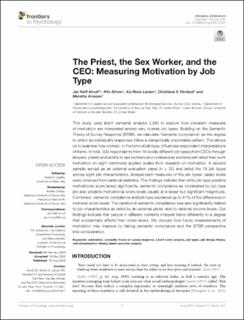| dc.description.abstract | This study uses latent semantic analysis (LSA) to explore how prevalent measures of motivation are interpreted across very diverse job types. Building on the Semantic Theory of Survey Response (STSR), we calculate “semantic compliance” as the degree to which an individual’s responses follow a semantically predictable pattern. This allows us to examine how context, in the form of job type, influences respondent interpretations of items. In total, 399 respondents from 18 widely different job types (from CEOs through lawyers, priests and artists to sex workers and professional soldiers) self-rated their work motivation on eight commonly applied scales from research on motivation. A second sample served as an external evaluation panel (n = 30) and rated the 18 job types across eight job characteristics. Independent measures of the job types’ salary levels were obtained from national statistics. The findings indicate that while job type predicts motivational score levels significantly, semantic compliance as moderated by job type job also predicts motivational score levels usually at a lesser but significant magnitude. Combined, semantic compliance and job type explained up to 41% of the differences in motional score levels. The variation in semantic compliance was also significantly related to job characteristics as rated by an external panel, and to national income levels. Our findings indicate that people in different contexts interpret items differently to a degree that substantially affects their score levels. We discuss how future measurements of motivation may improve by taking semantic compliance and the STSR perspective into consideration. | en_US |
